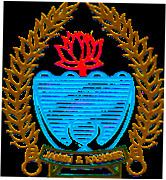Type Lower House Speaker of the Assembly Kavinder Gupta, BJP | Founded 1957 | |
 | ||
Deputy Speaker of the Assembly Nazir Ahmad Khan Gurezi, JK NC Deputy Leader of Assembly(Deputy Chief Minister) Nirmal Kumar Singh, BJP | ||
The Legislative Assembly of Jammu and Kashmir (also known as the Jammu and Kashmir Vidhan Sabha) is the lower house of the bicameral legislature of the Indian state of Jammu and Kashmir, which is known as the Jammu and Kashmir State Legislature. It has 87 members.
Contents
History
The first legislature of the kingdom that is now the Indian state of Jammu and Kashmir was established by the government of the Maharaja of Kashmir Hari Singh in 1934. However, it was considered undemocratic and unrepresentative by a majority of the population of the kingdom owing to the restrictions on the participation of political parties such as the Jammu and Kashmir National Conference led by Sheikh Mohammad Abdullah. After the accession of the princely state of Jammu and Kashmir to the Union of India in 1947, the Maharaja had to cede powers to a popular government headed by Sheikh Abdullah. With free democratic elections held for the first time in the state's history, the National Conference won a majority of seats in a new constituent assembly and Sheikh Abdullah became an elected head of government.
In 1957, a new constitution was adopted by the constituent assembly, which established a bicameral legislature.
Composition
The Legislative Assembly was initially composed of 100 members, later increased to 111 by the Constitution of Jammu and Kashmir (Twentieth Amendment) Act of 1988. Of these, 24 seats are designated for the territorial constituencies of the state that were occupied by Pakistan in 1947. These seats remain officially vacant as per section 48 of the state constitution. These seats are not taken into account for reckoning the total membership of the Assembly, especially for deciding quorum and voting majorities for legislation and government formation. Hence the total contestable and filled seats of the assembly are presently 87.
The Kashmir valley region has 46 seats, the Jammu region has 37 seats and the Ladakh region has 4 seats.
Two women may be nominated as members by the Governor of Jammu and Kashmir if he is of the opinion that women are not adequately represented.
Tenure and functions
Members of the Legislative Assembly are elected for a six-year term. The seats are filled by direct election. The assembly may be dissolved before the completion of the six-year term by the Governor upon the advice of the Chief Minister of Jammu and Kashmir. The Governor may also convene special sessions of both houses of the state legislature.
Office bearers
The Assembly is convened and administered by the Speaker. The leader of the house is usually the Chief Minister, who is the leader of the party (or coalition of parties) whose members constitute a majority. The leader of the opposition represents the party (or coalition of parties) that has won the second-largest number of seats.
Attack on the State Assembly Complex
On 1 October 2001 armed terrorists belonging to Jaish-e-Mohammed carried out an attack on the Jammu and Kashmir State Legislative Assembly Complex in Srinagar using a car bomb and three suicide bombers .
